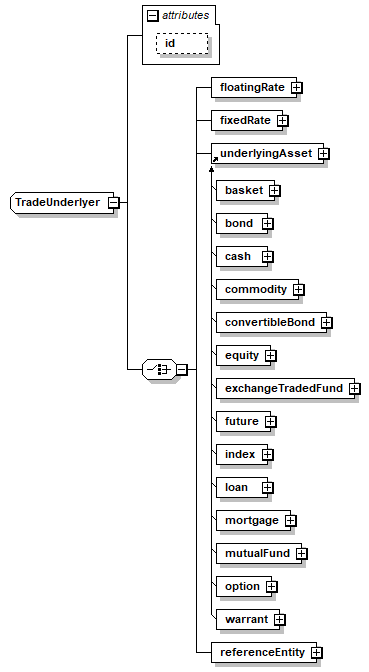complexType "TradeUnderlyer"
Namespace: |
|
Content: |
|
Defined: |
|
Includes: |
|
Used: |
|
XML Representation Summary |
<... |
|
|
|
> |
|
|
</...> |
Content Model Elements (4):
-
All Direct / Indirect Based Elements (2):
-
Annotation
The underlying asset/index/reference price etc. whose rate/price may be observed to compute the value of the cashflow. It can be an index, fixed rate, listed security, quoted currency pair, or a reference entity (for credit derivatives).
XML Source (w/o annotations (5); see within schema source)
<xsd:choice>
</xsd:choice>
<xsd:attribute name="id" type="xsd:ID"/>
</xsd:complexType>
|
Attribute Detail (all declarations; defined within this component only; 1/1)
 id
id-
Type: |
xsd:ID, predefined |
Use: |
optional |
XML Source (see within schema source)
<xsd:attribute name="id" type="xsd:ID"/>
|
Content Element Detail (all declarations; defined within this component only; 4/4)
-
The fixed rate or fixed rate schedule expressed as explicit fixed rates and dates. In the case of a schedule, the step dates may be subject to adjustment in accordance with any adjustments specified in calculationPeriodDatesAdjustments.
XML Source (w/o annotations (1); see within schema source)
-
A floating rate.
XML Source (w/o annotations (1); see within schema source)
-
The corporate or sovereign entity on which you are buying or selling protection and any successor that assumes all or substantially all of its contractual and other obligations. It is vital to use the correct legal name of the entity and to be careful not to choose a subsidiary if you really want to trade protection on a parent company. Please note, Reference Entities cannot be senior or subordinated. It is the obligations of the Reference Entities that can be senior or subordinated. ISDA 2003 Term: Reference Entity
XML Source (w/o annotations (1); see within schema source)
-
Type: |
|
Abstract: |
(may not be used directly in instance XML documents) |
Subst.Gr: |
|
Define the underlying asset, either a listed security or other instrument.
XML Source (w/o annotations (1); see within schema source)

